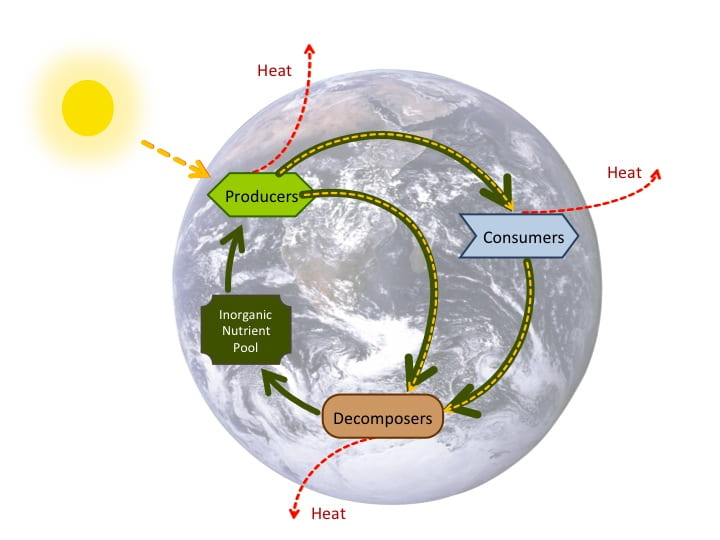
Credit: Biogeochemical cycles by Eva Horne and Robert A. Bear
Biochemical cycles are the pathways by which elements like carbon, phosphorus, nitrogen, and sulfur, or compounds like water, flow between living organisms and the environment.
Human activities can alter these cycles by producing or consuming in different quantities. For example, agricultural fertilizer and soil erosion have substantially increased levels of biologically available nitrogen and phosphorous in natural systems [1]. Human production of biologically available nitrogen, primarily driven by the synthetic production of nitrogen fertilizer, is now greater than all forms of natural products combined. The flow of phosphorous into the oceans, primarily driven by the use of fertilizer from mines and livestock manure, is roughly three times the preindustrial level [2].
Excess nitrogen decreases plant diversity in terrestrial ecosystems, and the combination of excess nitrogen and phosphorous in water bodies leads to algal blooms and eutrophication [3].
Robotic Solutions for Biochemical Flows
Till today, robotic solutions to chemical problems are difficult and there is no substantial research done. However, the issues affecting biochemical flows stem from farming practices; thus, it is possible to implement robotic solutions to biochemical flows by extending these robotic solutions to agricultural practices. There are numerous start-up corporations, such as Tortuga AgTech, that develop robots that can practice safe farming techniques, like seeding, along with other services such as soil composition analysis. These techniques not only assist farmers with their work but also help provide the necessary analysis of the nitrogen and phosphorus composition of the soil.
To see robotic solutions developed for maintaining the Biochemical Flows, click here.
To deep dive into the research publications about Biochemical Flows, click here.
| Prev: Ocean Acidification | Next: Freshwater Use |
References:
[1] Melillo, J. M. (2021). Disruption of the global nitrogen cycle: A grand challenge for the twenty-first century. Ambio, 50(4), 759–763.
[2] Yuan, Z., Jiang, S., Sheng, H., Liu, X., Hua, H., Liu, X., & Zhang, Y. (2018). Human Perturbation of the Global Phosphorus Cycle: Changes and Consequences. Environmental Science and Technology (Vol. 52, Issue 5, pp. 2438–2450).
[3] Steffen, W., Richardson, K., Rockström, J., Cornell, S. E., Fetzer, I., Bennett, E. M., Biggs, R., Carpenter, S. R., de Vries, W., de Wit, C. A., Folke, C., Gerten, D., Heinke, J., Mace, G. M., Persson, L. M., Ramanathan, V., Reyers, B., & Sörlin, S. (2015). Planetary boundaries: Guiding human development on a changing planet. Science, 347(6223)